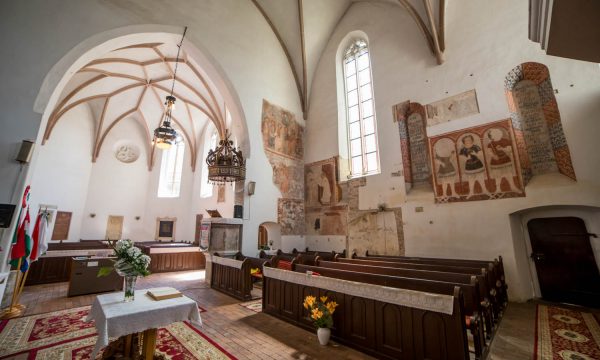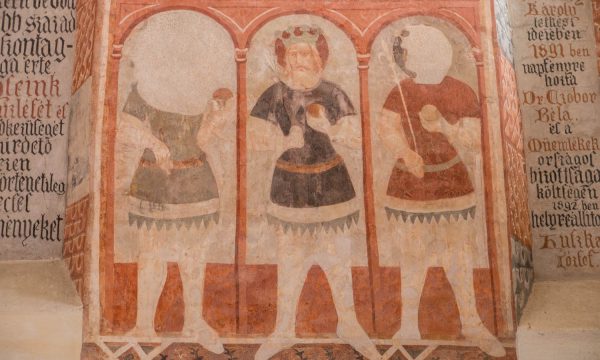Wall painting
The imposing church built in several medieval construction phases suffered a great deal of damage during a fire caused by a lightning strike in 1909, after which it was restored by the National Committee for Historic Monuments based on the designs of Ottó Sztehlo.

Nevertheless, its construction history still presents many unresolved questions, some of which were answered by Tamás Emődi’s observations and researches during the church’s most recent renovation, but a complete research of the building could not be carried out at that time either. The construction of the church with a polygonal chancel closed with three sides of an octagon can be dated to the first half of the 14th century. However, the Gothic church possibly connected to Csanád Telegdi, archbishop of Esztergom, was preceded by a smaller sized building. At that time the nave was much shorter, having small Gothic windows that were walled up during a subsequent Gothic reconstruction. Its late Gothic net vaulting resting on a central pillar was presumably built at that point. The construction that can be connected to István Telegdi’s name is dated by the Renaissance tabernacle from 1507. The Renaissance tombstone of István Telegdi dating from the early 16th century, as well as the one of Mikós Telegdi from 1560 are found in the church. Incidentally, Miklós Telegdi was the first from his family to convert to the protestant faith, after which the church belonged to the Reformed congregation. The church’s destruction is likely to have occurred in 1660. Its collapsed vaults were replaced with a wooden ceiling, and a painted gallery was also built, which is only documented by an 1879 drawing by Ferenc Storno. We have information about a large-scale renovation of the church in 1724, and its painted masonry pulpit was set up in 1742. Two carved, painted epitaphs, considered to be rare in the context of Hungarian heritage, have survived from the turn of the 18th century. The tower was erected between 1791 and 1793. In 1881, during repair works, mediaeval wall paintings were found on the triumphal arch and on the nave’s southern wall, which were restored by József Huszka according to the period’s standards. This meant the repainting and reconstruction of almost the entire surface. In 1909, the church burned down as a result of a lightning strike, after which, based on the designs of Ottó Sztehlo, the late Gothic vault was rebuilt from concrete reinforced with mesh wire, but without following the original state faithfully. This was the time when the tracery of the nave’s windows was also reconstructed, but the church’s highly damaged wall paintings were not restored. The most damaged ones of these were whitewashed.

Even its southern façade was once decorated with frescoes, of which a Man of Sorrows with extended arms and a praying figure were recognisable in the past, however, this large wall painting has unfortunately been lost by today.
On the southern side of the triumphal arch, in its upper part, angels are seen with the instruments of Passion and with six apostles under them. Below is the scene of the Last Judgement where the damned souls are banished to hell by Archangel Michael. In the lowest section a holy bishop can be seen with his hands raised in blessing. On the nave’s southern wall the following were painted: Annunciation, Coronation of the Virgin, one of the miracles of Saint Nicholas, a holy monk, and located between the two early walled-up windows, Saint Ladislaus, Saint Stephen, and Saint Emeric. These paintings are encased by frames with alternating decorations: some simple, with lines, others highly ornamental, with repetitive patterns. The brightly coloured,
richly decorated motifs are continued in the splays of the early windows.
The cult of the three Hungarian holy kings and their collective representation emerged and gained popularity during the Angevine dynasty, especially the reign of Louis the Great.
At Tileagd the figures represented in frontal position are framed by an architectural composition with semicircular arches. Their clothes are identical, only the colourings differ. The figures can be identified based on their attributes; according to the commonly used formula, Saint Ladislaus is on the left, probably with a short-handled battle axe in his right hand, but when his face was mutilated, the head of the latter was also destroyed.
Natural Heritage
From the viewpoint of nature conservation, several valuable natural habitats are worth paying attention to in the areas surrounding Tileagd. From a human standpoint, the value of these areas is also clear: the flat lands are fit for cultivation, the hills for growing grapes, and the waters are also suitable for fishing. But humans are not the only species living here, the flora and fauna of the area are just as important as the economic possibilities.
The Crişul Repede Natura 2000 site is the most important of these habitats. It is made up of a section of the Crişul Repede (Hu: Sebes-Kőrös) river and the large reservoir on the edge of Tileagd. The European bullhead (Cottus gobio) is one of the valuable fish species of this river section. Its Hungarian name, botos kölönte (stick bullhead), comes from being used to be caught with harpoons fixed to sticks, but today it is protected. In 2006, it was chosen “fish of the year” in Germany. Another notable fish is the European bitterling (Rhodeus sericeus amarus), which not only features beautiful bright colorus, but also helps maintaining the thick shelled river mussel (Unio crassus), found on the Red List of Threatened Species. The mussel’s larvae survive the early stage of their lives by sticking onto the gills of the bitterling’s young hatchlings, which in turn are protected by mussel.
Only few of the marshes that used to surround the river survived to this day due to river regulation, and these few are home to several protected species such as the native European pond turtle (Emys orbicularis), the smooth newt (Triturus vulgaris) and the yellow-bellied toad (Bombina bombina, B. variegata). In the winter, the reservoir, which doesn’t entirely freeze over, provides a resting place for such migratory birds as the Common scoter (Melanitta nigra), nesting further north, and the red-breasted merganser (Mergus serrator), which generally spends little time on land. Both of these birds are on the Red List of Threatened Species.
